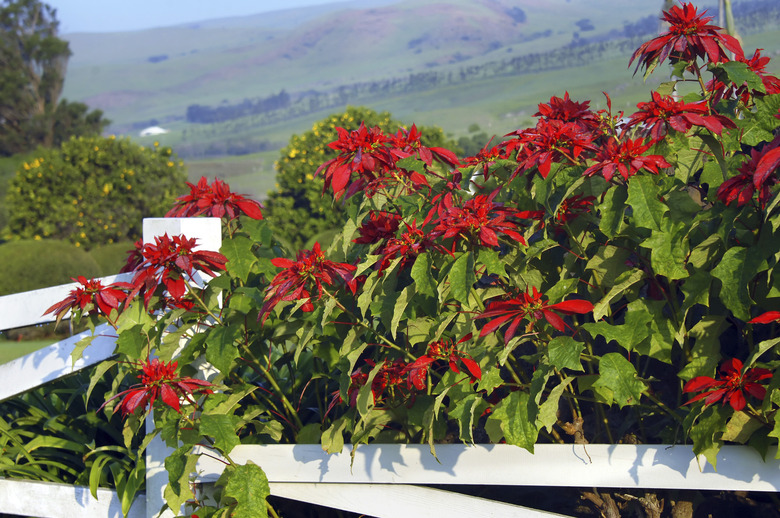How To Transplant A Poinsettia To Your Garden
A poinsettia (Euphorbia pulcherrima) will grow into a large shrub when transplanted outdoors in the warm climates of its perennial range in USDA zones 9-11. Traditionally grown as a potted holiday plant, over time the plant may grow 3 to 10 feet tall and 3 to 7 feet wide. But for a repeat performance of its brilliant red holiday display, poinsettia must experience long hours of uninterrupted darkness at night during fall and winter.
Preparing for Transplanting
Preparing for Transplanting
Spring is the best time for transplanting a poinsettia into the garden, after preparing the plant. As the bright red bracts fade, water the poinsettia when the soil surface is dry to a depth of 1/2 inch, and don't apply fertilizer. Bracts are the modified leaves that give poinsettia its red coloring. Prune the stems when the bracts turn muddy green around May. Wipe the pruning shear blades with a cloth dipped in rubbing alcohol, and prune the stems to 4 to 6 inches long. Make sure to sanitize the pruning shears again when you've finished.
It's important to wear gloves when you prune your plants because the milky sap may irritate your skin. Fertilize the poinsettia with a houseplant fertilizer, such as a 12-4-8 liquid product diluted at a rate of 1 teaspoon per 1 gallon of water, or according to the manufacturer's instructions. You'll only need to apply the fertilizer every two weeks. When all danger of frost has passed, place the poinsettia in its pot outdoors, in a warm, partially shady spot sheltered from the wind.
Selecting a Site
Selecting a Site
A full-sun site with moist, acidic soil provides the right growing conditions for a poinsettia. When the poinsettia has been outdoors for two weeks or longer, it will have adjusted to outdoor light levels and temperatures and be ready for transplanting into the garden. This shrub prefers a soil pH between 5.5 and 6.5, but it also grows well in soils with a pH of 5.0 to 7.0. Select a site that isn't exposed to artificial lighting at night if you're growing a poinsettia for its bright red bracts.
Transplanting a Poinsettia
Transplanting a Poinsettia
The hole for a poinsettia should be 1 foot wider than the root ball of the plant but no deeper than the bottom of the roots. Break up the soil if it's lumpy, and refill the hole so that the surface of the soil in the container will be level with the surrounding ground. Gently slide the plant out of its pot, avoiding pulling on it. Take extra care with the stems because they can be fragile and brittle.
If the poinsettia doesn't slide out, tap the edge of the pot on the ground to loosen the soil. Place the poinsettia in the hole and fill in the gaps with the excavated soil. Gently firm the ground. Water the poinsettia with a garden hose and soft spray attachment, until water begins to puddle.
Caring for a Poinsettia Outdoors
Caring for a Poinsettia Outdoors
Watering and fertilizing a newly planted poinsettia helps the shrub establish well. Spread a 2-inch layer of organic mulch, such as shredded bark or leaf mold, over the planted area to help conserve soil moisture. Fertilize the poinsettia with a high-nitrogen product, such as a 12-4-8 liquid fertilizer, following all label directions.
Manufacturer's instructions vary, so read and follow the product label for rate and frequency of reapplication. Poinsettia doesn't tolerate drought. Water the shrub when the soil surface is dry, but don't apply so much water that the ground becomes soggy.
